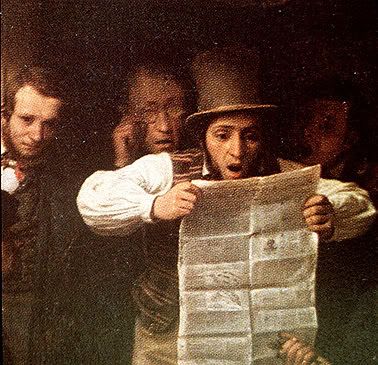Cuadros -Richard Caton Woodwille-

War News from Mexico
Cuadro de Richard Caton Woodwille
Richard Caton Woodwille
Born London 1856; died there 1927. Woodville was the most prolific 'battle' artist of the nineteenth and early twentieth century in Britain, producing countless oil paintings and drawings, many for the Illustrated London News. As was the case with several history painters of the Victorian period, he studied at Dusseldorf sometime with Wilhelm Camphausen, the great German military painter, and later in Paris. He experienced was first-hand in Albania and Montenegro towards the end of the Russo-Turkish War in 1877, and later in Egypt during the war of 1882. During the latter conflict, he made numerous sketches and obtained photographs of the trenches at Tel-e-Kebir for his friend, the French military artist, Alphonse de Neuville (q.v.) who had been commissioned to paint a scene of the battle. The fruits of both their labours were shown at the Fine Art Society in 1883, Woodville, exhibiting The Moonlight Charge at Kassassin. In 1884, Woodville exhibited by Royal Command, another picture relating to the Egyptian War. The Guards at Tel-e-Kebir (Royal Collection).
His first Royal Academy picture exhibited in 1879, was entitled Before Leuthen, Dec. 3rd, 1757. Thereafter, he was a frequent exhibitor at Burlington House, showing no less than 21 battle pictures, many dealing with contemporary events such as the Second Afghan War, Candahar (Private collection) and Maiwand; saving the Guns (Walker Art Gallery, Liverpool), the Zulu War - Prince Louis Napoleon in Zululand, and the Boer War - Lindley; Whitsunday 1900 (Oxfordshire Light Infantry Association), and Dawn of Majuba (Canadian Military Institute).
He painted many historical recreations both in oil and water-colour including a series on famous British battles for the Illustrated London News. He depicted The Charge of the Light Brigade (Royal Collection, Madrid) and The Charge of the 21st Lancers at Omdurman (Walker Art Gallery, Liverpool), Blenheim, Badajos and several Waterloo pictures. During the Great War, he turned his talents to depicting the current events, three of which were exhibited at the Royal Academy. The 2nd Batt. Manchester Regiment taking six guns at dawn near St. Quentin (The Ring's Regiment), Entry of the 5th Lancers into Mons (16th/5th Royal Lancers), and Halloween, 1914: Stand of the London Scottish on Messines Ridge (London Scottish Museum Trust) exhibited in the year of his death.
During his life, he was the most popular artist of the genre and he was the subject of several articles in magazines and journals. He himself wrote some memoirs in 1914 entitled Random Recollections. He was deeply interested in the army and joined the Royal Berkshire Yeomanry Cavalry in 1879, staying with them until 1914 when he joined the National Reserve as a Captain.
Cuadro de Richard Caton Woodwille
Richard Caton Woodwille
Born London 1856; died there 1927. Woodville was the most prolific 'battle' artist of the nineteenth and early twentieth century in Britain, producing countless oil paintings and drawings, many for the Illustrated London News. As was the case with several history painters of the Victorian period, he studied at Dusseldorf sometime with Wilhelm Camphausen, the great German military painter, and later in Paris. He experienced was first-hand in Albania and Montenegro towards the end of the Russo-Turkish War in 1877, and later in Egypt during the war of 1882. During the latter conflict, he made numerous sketches and obtained photographs of the trenches at Tel-e-Kebir for his friend, the French military artist, Alphonse de Neuville (q.v.) who had been commissioned to paint a scene of the battle. The fruits of both their labours were shown at the Fine Art Society in 1883, Woodville, exhibiting The Moonlight Charge at Kassassin. In 1884, Woodville exhibited by Royal Command, another picture relating to the Egyptian War. The Guards at Tel-e-Kebir (Royal Collection).
His first Royal Academy picture exhibited in 1879, was entitled Before Leuthen, Dec. 3rd, 1757. Thereafter, he was a frequent exhibitor at Burlington House, showing no less than 21 battle pictures, many dealing with contemporary events such as the Second Afghan War, Candahar (Private collection) and Maiwand; saving the Guns (Walker Art Gallery, Liverpool), the Zulu War - Prince Louis Napoleon in Zululand, and the Boer War - Lindley; Whitsunday 1900 (Oxfordshire Light Infantry Association), and Dawn of Majuba (Canadian Military Institute).
He painted many historical recreations both in oil and water-colour including a series on famous British battles for the Illustrated London News. He depicted The Charge of the Light Brigade (Royal Collection, Madrid) and The Charge of the 21st Lancers at Omdurman (Walker Art Gallery, Liverpool), Blenheim, Badajos and several Waterloo pictures. During the Great War, he turned his talents to depicting the current events, three of which were exhibited at the Royal Academy. The 2nd Batt. Manchester Regiment taking six guns at dawn near St. Quentin (The Ring's Regiment), Entry of the 5th Lancers into Mons (16th/5th Royal Lancers), and Halloween, 1914: Stand of the London Scottish on Messines Ridge (London Scottish Museum Trust) exhibited in the year of his death.
During his life, he was the most popular artist of the genre and he was the subject of several articles in magazines and journals. He himself wrote some memoirs in 1914 entitled Random Recollections. He was deeply interested in the army and joined the Royal Berkshire Yeomanry Cavalry in 1879, staying with them until 1914 when he joined the National Reserve as a Captain.
Más cuadros del artista
Labels: Cuadros

0 Comments:
Post a Comment
<< Home